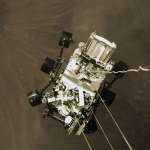Dominique Luchart's Blog, page 632
May 6, 2021
On This Day in Space! May 6, 1968: Neil Armstrong Narrowly Escapes Fiery Crash, ,

On May 6, 1968, NASA astronaut Neil Armstrong almost met his fate while simulating a lunar landing. This was a little over a year before he would become the first person to walk on the moon.
Armstrong was flying in a machine called the Lunar Landing Research Vehicle at Ellington Air Force Base in Houston when some leaking propellant caused a total failure of the flight controls. After tumbling around in the air for a few seconds, it started to fall out of the sky.
[image error]
Astronaut Neil A. Armstrong, Apollo 11 mission commander, floats safely to the ground in this photo from May 6, 1968. The Lunar Landing Research Vehicle (LLRV) exploded only seconds before while Armstrong was rehearsing a lunar landing at Ellington Air Force Base near the Manned Spacecraft Center (MSC). The photo is a blowup of 16mm documentary motion picture recorded during the mishap. trainer crash. (Image credit: NASA)Armstrong had to eject himself from the simulator when it was just 30 feet above the ground, and he safely parachuted down while his aircraft crashed and burned. If he had waited even just one second longer to hit the eject button, he would have been killed by the fiery explosion.
But Armstrong kept his cool the whole time, and he went right back to work in his office after the accident.
Catch up on our entire “On This Day In Space” series on YouTube with this playlist.
[image error]
History of NASA: $22.99 at Magazines Direct
Discover the story of how and why NASA was created, its greatest triumphs, darkest days, and of the times it exceeded all possible hopes. A tale of adventure, heroism and resourcefulness, learn of the space agency’s greatest achievements and how — over six decades — the organization has consistently and tirelessly devoted itself to its founding principle: that “activities in space should be devoted to peaceful purposes for the benefit of all humankind”. View Deal
Still not enough space? Don’t forget to check out our Space Image of the Day, and on the weekends our Best Space Photos and Top Space News Stories of the week.
Email Hanneke Weitering at hweitering@space.com or follow her @hannekescience. Follow us @Spacedotcom and on Facebook.
Join our Space Forums to keep talking space on the latest missions, night sky and more! And if you have a news tip, correction or comment, let us know at: community@space.com.
The post On This Day in Space! May 6, 1968: Neil Armstrong Narrowly Escapes Fiery Crash, , appeared first on NEWDAWN Blog.
Why the bad iPhone web app experience keeps coming up in Epic v. Apple,


Something keeps coming up at the Epic v. Apple trial as a potential alternative for getting Fortnite on the iPhone: web apps. It’s an intriguing idea, as web apps are able to do surprisingly complex things: just look at a Chromebook or even game streaming services on the iPhone. But potential is far from reality, because the ability for web apps to look, feel, and perform as well as native apps on iOS is severely limited.
These web apps aren’t the preferred way for consumers or developers to use or create apps on the iPhone, either. But Apple has forced companies like Microsoft and Nvidia to use web apps, instead of native ones available in the App Store.
Though the term itself hasn’t really come up explicitly, what’s being discussed are Progressive Web Apps, or PWAs. If you’re unfamiliar, think of them as slightly more advanced web apps that you can “install” directly from your web browser on to your home screen. Google has been pushing the idea (though support for PWAs on its own platforms is a little mixed), and some companies like Microsoft and Twitter have wholeheartedly embraced PWAs.
Not Apple, though. There are a variety of reasons for that — ranging from genuine concern about giving web pages too much access to device hardware to the simple fact that even Apple can’t do everything. There’s also the suspicion that Apple is deliberately dragging its feet on support for features that make PWAs better as a way to drive developers to its App Store instead.
 Fortnite running on an iPhone before its removal.Photo by Tom Warren / The Verge
Fortnite running on an iPhone before its removal.Photo by Tom Warren / The VergeBut the App Store has restrictions that aren’t tenable for some developers. That’s the whole crux of this trial for Epic, after all. On the stand, a Microsoft executive detailed the company’s struggles to get its xCloud game streaming service onto iOS. Lori Wright, VP of Xbox business development at Microsoft, revealed the company spent around four months talking to Apple to try and get xCloud launched as a native app. Apple seemed, initially open to the idea of letting Microsoft use the same model as Netflix or Audible. But Apple changed its mind and forced Microsoft, Nvidia, and others to list cloud games as separate apps.
Submitting Xbox games one-by-one was simply a nonstarter for Microsoft, so it resorted to making a web app. In addition to the technical hurdles a web app involves, it also introduces a discoverability issue. Users simply aren’t used to installing apps from the web on their iPhones. Apple has effectively trained everybody that if they want an app, they go to the App Store.
Wright essentially admitted that the only reason Microsoft is releasing Xbox Cloud Gaming (xCloud) as a web app is because Apple’s terms on the App Store are too onerous. “People don’t play games through the browser on iPhone,” said Wright, but “it was our only outcome in order to reach mobile users on iOS.”
Even the judge in the case seemed confused by Apple’s rule, which says that services that stream movies can offer them all in a single app but services that stream games have to separate each game for individual listing and review. “I can use Netflix with a native app and I can see lots of different movies or TV shows or whatever. Is it that you didn’t want to use a subscription model?” Judge Yvonne Gonzalez Rogers asked at one point.
 Apple has forced Microsoft and others to head to the web for gaming streaming.Photo by Nick Statt / The Verge
Apple has forced Microsoft and others to head to the web for gaming streaming.Photo by Nick Statt / The VergeBut back to those technical hurdles: they’re tall, numerous, and can be blamed both on the nature of web apps and Apple’s own decisions. Safari on the iPhone only recently became capable of supporting a service like Xbox Cloud Gaming via specific controller support. Until then, that sort of thing was on the list of features Apple was reticent to include in Safari. There are legitimate reasons to block things like Bluetooth access from web apps, including fingerprinting for tracking, but it was getting harder to justify and Apple needed some kind of escape valve as pressure mounted to support cloud gaming services.
Google software engineer Alex Russell recently published a very comprehensive list of all the features that Safari on iOS doesn’t support yet — and it’s a long list. For PWAs to truly be a viable alternative to App Store apps, there are at least a few of these features that need to be enabled. The inability to send push notifications via a web app, for example, is particularly galling as it’s already possible on Safari on macOS. An app that can’t send notifications is simply not competitive with an app that can.
Grant is touching on some more of the benefits to native versus web apps; push notifications and ARKit both come up. The former is another example of Apple letting native apps reduce friction points — Epic needs to convince the judge these smaller features are meaningful.
— Adi Robertson (@thedextriarchy)
As Russell notes, his “interests and biases are plain” as a Google engineer. But it doesn’t change the fact that there are many things that a PWA cannot do on the iPhone that a developer like Epic would need to support Fortnite as a web app.
“Native [iPhone] apps would have access to a far wider range of APIs than web apps,” explained Andrew Grant, engineering fellow at Epic Games, during the trial. “Access to things like push notifications, to Siri, to health data, and augmented reality features” are also limited to native apps, said Grant. Web apps also have to be far smaller than native apps, and are capped at about 50MB in size.
Plus, from a simple performance perspective, web apps have more overhead than native apps — and lack access to Apple APIs that can speed up games like Fortnite.
In fact, this was a sticking point for a lot of the questioning of an Nvidia employee. Nvidia, like Microsoft, has been trying to get its GeForce Now cloud gaming service into the App Store, but has faced the same restrictions that Microsoft is struggling with. Nvidia director of product management Aashish Patel spent a lot of time answering questions around latency in a browser and the benefits of using native apps.
“There are less controls over the streaming, so you could argue in some ways it’s worse,” than a native app, said Patel. Developers are also locked into using the video codecs provided in Safari on iOS, whereas they could use alternatives that might be better at handling latency inside a native iOS app.
 All iOS browsers run the same WebKit engine underneath.Photo by Amelia Holowaty Krales / The Verge
All iOS browsers run the same WebKit engine underneath.Photo by Amelia Holowaty Krales / The VergeAll of this is compounded by yet another Apple policy: no third party browser engines. You can install apps like Chrome, Firefox, Brave, DuckDuckGo, and others on the iPhone — but fundamentally they’re all just skins on top of Apple’s Webkit engine. That means that Apple’s decisions on what web features to support on Safari are final. If Apple were to find a way to be comfortable letting competing web browsers run their own browser engines, a lot of this tension would dissipate.
As it relates to Epic v. Apple, a lot of this PWA discussion isn’t germane to the fundamental arguments in the case. Fortnite as a PWA would necessarily be a streaming app instead of a native game and that introduces an entirely different set of compromises. Which is why it’s so fascinating to see Apple’s lawyers float web apps as a potential solution — because web apps on the iPhone are famously more limited than they are on other platforms, including even Apple’s macOS.
The human-readable versus machine-readable code bit is back now — Grant is talking about how web apps don’t go through the same kind of compilation process that increases processing efficiency, yet another reason they’re not as good as native apps.
— Adi Robertson (@thedextriarchy)
Even if every single browser feature was available on mobile Safari or even if Apple allowed alternative browser engines on the iPhone, a web app will never match the performance of a native app. At the end of the day, though, all the discussion of web apps in the Epic v. Apple case highlight the limitations of Apple’s App Store policies, not PWAs.
The post Why the bad iPhone web app experience keeps coming up in Epic v. Apple, appeared first on NEWDAWN Blog.
Radiation resistance is baked into the Perseverance Mars rover. Here’s why that’s important., ,

Think about the number of times your computer on Earth has crashed. Now imagine how challenging that would be during a rover mission on Mars.
From time to time, the Curiosity rover has gone into “safe mode” to deal with glitches and software problems since it landed on Mars in August 2012. But each time, the mission has recovered to continue its epic climb up a Martian mountain in search of habitable environments.
All those “lessons learned” from safe mode incidents are now embedded into the new Perseverance rover, the more powerful cousin of Curiosity that started rolling on Mars on March 5.
Related: Mars helicopter Ingenuity spots Perseverance rover from the air (photo)
Recovering from glitches takes technical skill, especially on Mars’ dusty, radiation-soaked surface. In many cases, radiation and circuits mix poorly. But that can’t be allowed to happen on Mars, where circuits on Perseverance control everything from the cameras to the laser, to the complex system that will cache potentially habitable rock samples for a future sample-return mission.
So what’s the solution? Xilinx — the company providing integrated circuits for several of Perseverance’s instruments — has had its technology on Mars since NASA’s Opportunity and Spirit rovers in 2004. Xilinx can’t give away all of its “secret sauce” that keeps the circuits safe — it’s proprietary — but a lot of it comes down to appropriate shielding and backup.
“We build the hardness in,” Minal Sawant, Xilinx’s director of the aerospace and defense vertical market, said of the company’s approach to keeping the circuits resistant to radiation. Sawant noted that several classified satellites have also used Xilinx circuits for long-standing missions in the harsh environment of radiation belts near Earth, so Xilinx has experienced radiation first-hand in Earth orbit and on Mars, and knows how to deal with it.
On Perseverance, the circuits are “triple-module redundant,” which means that Xilinx manufactures three copies of each circuit powering an instrument or a camera on the rover. “If one [circuit] gets hit, the other two still function. That’s how you ensure it’s hardened,” Sawant said.
The job gets harder with each successive generation of rover because the circuitry gets denser. That’s because each rover is tasked with gathering and transmitting more information to Earth than previous missions. “As we innovate more and more, there’s more density added,” Sawant explained.
There also are more possible points of failure with each generation of rover. For example, Spirit and Opportunity each carried only nine cameras; Perseverance has 23. The instruments and tasks have grown ever-more complex, too. Remarkably, however, Xilinx’s circuitry has stood the test of time.
Spirit and Opportunity were supposed to last 90 Earth days on Mars, but each lasted several years. Curiosity — which also carries Xilinx products — had a two-year prime mission after landing in 2012, but is still going strong after nearly seven Earth years on the Red Planet. Given that track record, Sawant is hopeful Perseverance will also survive for a long time.
[image error]
An image of NASA’s Curiosity rover on Mars composed of 57 separate photographs the rover took on May 12, 2019. (Image credit: NASA/JPL-Caltech/MSSS)One way to make the integrated circuits more responsive is to design them to be easily adjustable. We all know the value of applying software updates to our computer, and doing the same for a rover on Mars is tremendously helpful. On Curiosity, for example, a software update in 2016 allowed the rover to be more autonomous in picking targets to laser. Xilinx aims to offer similar flexibility for its integrated circuits.
“We make these chips that are very configurable,” Sawant said. “A designer or a user can put a specific algorithm or design in it, and do the function. It’s not a fixed function, but more of a programmable function … an ability to change as needed.”
Xilinx’s systems have already survived a powerful test with Perseverance. The circuits were used in the “vision compute” element of Perseverance’s landing system that enabled it to pick the right spot to land on Mars. Specifically, Xilinx products handled visual tasks like image filtering, detecting and matching. Another crucial part of the landing involved Perseverance’s range and velocity measurements, using a radar terminal descent sensor powered by Xilinx technology.
Sawant pointed out that even though those landing systems don’t need to survive for years on the surface, they have to go through several months of travel, experiencing the shaking of launch, the extreme cold and hot environments of space, and space radiation.
Xilinx’s integrated circuits are used in four instruments on Perseverance, all designed to withstand years of Mars radiation. These instruments are the Planetary Instrument for X-ray Lithochemistry, or PIXL, which identifies chemical elements; a UHF transceiver to relay telecommunications; Mastcam-Z, which takes panoramic pictures of the surface; and Scanning Habitable Environments with Raman and Luminescence for Organics and Chemicals, or SHERLOC, which performs fine-scale detection of minerals, organic molecules and potential signs of life.
Xilinx circuitry is also working well on the NASA OSIRIS-REx (Origins, Spectral Interpretation, Resource Identification, Security-Regolith Explorer) mission to asteroid Bennu, which has been in space since 2016 and won’t return with samples to Earth until 2023. Xilinx aims to launch its technology on the NASA Europa Clipper mission to orbit the icy Jupiter moon, too, which may require six years of cruise time in space after its planned 2024 launch.
Xilinx is one of several companies powering systems and instruments on the Perseverance rover. Another is Vaisala, working with the Finnish Meteorological Institute (FMI). The collaboration provided sensors for the Spanish-led Mars Environmental Dynamics Analyzer on board the rover — a Red Planet weather station that examines temperature, wind speed and direction, relative humidity and dust particles, and more. This group is also aware how challenging Mars can be.
“The rover’s equipment needs to operate in the harsh Martian environment, with very low pressure conditions and cold temperatures, and it must be able to resist possible global dust storms,” Maria Genzer, FMI’s head of planetary research and space technology group, said in a statement in February. “In addition to the environmental aspects … the distance between Mars and Earth makes the mission challenging. There is no one to fix the instrumentation if something goes wrong.”
As for Xilinx, the newest generation of its integrated circuits — released in May 2020 — will not only be resistant to radiation in multiple orbits around Earth or missions across the solar system, but will also include a machine-learning ecosystem. Machine learning (a facet of artificial intelligence) enables computers to learn from a dataset and to apply that information to make decisions.
With an Earth-orbiting satellite, for example, one application could be discarding optical images that include clouds, and only sending down images with clear conditions, Sawant said. More broadly, machine learning has already been used on Mars for applications such as identifying new craters.
Follow Elizabeth Howell on Twitter @howellspace. Follow us on Twitter @Spacedotcom and on Facebook.
The post Radiation resistance is baked into the Perseverance Mars rover. Here’s why that’s important., , appeared first on NEWDAWN Blog.
Welcome to Mars! Bill Nye and Robert Zubrin hail new Red Planet visitors., ,

Two prominent space advocacy groups are cheering the new generation of Mars explorers.
While NASA’s newly landed Perseverance rover is getting the lion’s share of coverage in the United States, both the United Arab Emirates and China also entered Mars orbit successfully in February.
The Planetary Society’s CEO Bill Nye expressed optimism that China’s Tianwen-1 mission might open up opportunities for collaboration between the country and the United States, which have had tricky international relations for decades over matters ranging from intellectual property to security concerns and human rights. Notably, Tianwen-1 is a planned triple mission — an orbiter, lander and rover — that hopes to touch down on Mars this spring.
Related: The boldest Mars missions in history
“Here is an example where the collaboration is going to be between scientists,” Nye told Space.com. “Yes, I understand the concern of the military. The technology, they don’t want to transfer it without [addressing] pirating, abuse of intellectual property rights and so on. But just that people are talking — that scientists in China and scientists in the West are talking about Mars — is really significant.”
The Mars Society’s president, Robert Zubrin, called the Chinese effort “a remarkable thing” after other recent achievements by the program, including the first lunar farside landing in 2019 and a lunar sample return mission in 2020. “It’s now merging into its rightful place with the world’s leading countries, and certainly this will encourage a lot of Chinese to become scientists and engineers. I think that’s why they did it,” Zubrin told Space.com.
The UAE’s Hope mission is also attracting attention for its emphasis on bringing science and engineering expertise to the tiny Arab country, which is investing heavily in education in preparation for a post-oil economy. Nye said that the old joke about the complication of rocket science applies in Hope’s case, calling the achievement “not trivial” because the UAE made it to orbit on the first try. “It’s not easy, man. And they done it. It’s really fantastic,” he said.
The UAE, China and previously India (whose Mars Orbiter Mission arrived at the Red Planet in 2014) represent a new generation of planetary explorers. Traditionally, Mars has been the province of large space agencies from the United States, the Soviet Union and Europe.
But changes in spacecraft technology such as miniaturization and cheaper rockets are enabling smaller space agencies to shoot much further into space than ever before. Satellites are smaller and more powerful thanks to advances in computing; the first-ever cubesats reached Mars in 2018 with NASA’s InSight mission. Rockets are also lighter and cheaper, due to the number of companies and countries manufacturing them in the past decade and ongoing improvements in metrics such as mass and materials.
Both Nye and Zubrin pointed to the context in which these newer space missions are happening, too. When NASA and the Soviet Union were slinging early missions to Mars in the 1960s, the two countries were competing in a political- and military-driven “space race” for dominance, which also fueled much of the push behind the Apollo moon landings between 1969 and 1972. While national pride is still on the line with these newer Mars missions, Nye and Zubrin acknowledged, they see a new emphasis on bringing the softer benefits of science and engineering to the public with each successful launch.
“What we’re striving for here is not dominance, but who can achieve the most expansive human knowledge,” Zubrin said, adding that as each smaller country makes it to Mars, it inspires other countries to go. “If you were to say in Chile right now, ‘Why don’t you do a Mars mission?’ it seems more possible because the UAE did it.”
The likelihood of these missions learning new things abut the cosmos is also exciting. “They’re doing it because it brings out the best in people, it brings out the best in their scientists and engineers and inspires the country, and you’re going to make discoveries that you didn’t anticipate,” Nye said of the new countries’ achievements. “You’re going to learn more about the cosmos. Then there’s the practical things — predicting the [Martian] weather and [testing] communication.”
Both the Mars Society and the Planetary Society advocate for space regularly among politicians and the American public, looking to gain more support for their individual mandates. The Mars Society, established in 1998, calls for exploring Mars and “creating a permanent human presence on the Red Planet,” according to its website. The Planetary Society blends in goals of space technology and giving individual humans worldwide a voice in planning through a mandate of “empowering the world’s citizens to advance space science and exploration.”
The Planetary Society’s short-term goals on Mars includes supporting ongoing planning for the sample-return mission and parsing early results from the NASA Ingenuity helicopter, which made the first-ever powered flights on Mars this year.
Related: Mars helicopter Ingenuity spots Perseverance rover from the air (photo)
“We have a helicopter sitting on Mars, everybody, this is not trivial,” Nye pointed out. Although he spoke with Space.com before the landmark flights, he noted the importance of the sorties and the project as a whole.
Adding a helicopter capability will be “really extraordinary” not only for the sheer value of flying, but also to give valuable context to geologists. “Rather than relying on orbiting cameras — which are extraordinary and give you amazing detail of the Martian surface — [you will] be this close to [the surface] with this drone … Come on. It’s just going to be fantastic.”
Zubrin added that he wouldn’t be surprised if SpaceX’s Elon Musk brings people to Mars in the near future. That said, he isn’t quite in agreement with Musk’s methodology, although they do share some elements such as using Mars resources in-situ for spacecraft fuel.
Simply put, Zubrin’s “Mars Direct” mission calls for an Earth Return Vehicle (ERV) that launches uncrewed to Mars and arrives at the Red Planet six months later; subsequently, a new ERV and astronaut habitat would fly to the Red Planet every 26 months to bring people and supplies to Mars. Musk’s Starship, by contrast, will zoom off to Mars by itself and then lift off itself at the end of the mission; there are no plans for a separate Mars base and Musk hopes to go quickly, as soon as 2024.
Zubrin says he doesn’t feel Starship is suited for a Mars takeoff due to its sheer size, but he did express admiration for Musk’s vision; the two men met early last year in Boca Chica, Texas, nearby where Starships typically launch. Zubrin says his impression is Musk wants to “get to it” with Mars exploration rather than waiting for a space agency like NASA to support him. “He is purpose-driven and he doesn’t do anything in order to please someone else,” Zubrin said.
Follow Elizabeth Howell on Twitter @howellspace. Follow us on Twitter @Spacedotcom and on Facebook.
The post Welcome to Mars! Bill Nye and Robert Zubrin hail new Red Planet visitors., , appeared first on NEWDAWN Blog.
Microsoft is finally ditching its Windows 95-era icons,

Microsoft is finally preparing to refresh its Windows 95-era icons. The software giant has been slowly improving the icons it uses in Windows 10, as part of a “sweeping visual rejuvenation” planned for later this year. We saw a number of new system icons back in March, with new File Explorer, folder, Recycle Bin, disk drive icons, and more. Microsoft is now planning to refresh the Windows 95-era icons you still sometimes come across in Windows 10.
Windows Latest has spotted new icons for the hibernation mode, networking, memory, floppy drives, and much more as part of the shell32.dll file in preview versions of Windows 10. This DLL is a key part of the Windows Shell, which surfaces icons in a variety of dialog boxes throughout the operating system. It’s also a big reason why Windows icons have been so inconsistent throughout the years. Microsoft has often modernized other parts of the OS only for an older app to throw you into a dialog box with Windows 95-era icons from shell32.dll.
 New vs. old Windows 95-era icons.Image: Windows Latest
New vs. old Windows 95-era icons.Image: Windows LatestHopefully this also means Windows will never ask you for a floppy disk drive when you dig into Device Manager to update a driver. That era of Windows, along with these old icons, has been well and truly over for more than a decade now.
All of this work to improve the consistency of Windows is part of Microsoft’s design overhaul to Windows 10, codenamed Sun Valley. The visual changes are expected to appear in the Windows 10 21H2 update that should arrive in October. Microsoft has not officially detailed its Sun Valley work, but a job listing earlier this year teased a “sweeping visual rejuvenation of Windows.”
Microsoft has so far revealed new system icons for Windows 10, alongside File Explorer icon improvements, and more colorful Windows 10 icons that appeared last year. Rounded corners will also be a big part of Sun Valley, alongside changes to built-in apps and the Start menu.
We’re expecting to hear more about Sun Valley at Microsoft’s Build conference later this month, or as part a dedicated Windows news event.
The post Microsoft is finally ditching its Windows 95-era icons, appeared first on NEWDAWN Blog.
Is there a pattern to the universe?, ,

Paul M. Sutter is an astrophysicist at SUNY Stony Brook and the Flatiron Institute, host of Ask a Spaceman and Space Radio, and author of How to Die in Space.
For decades, cosmologists have wondered if the large-scale structure of the universe is a fractal — that is, if it looks the same no matter how large the scale. After completing massive surveys of galaxies, scientists finally have an answer: No, but kind of, in a way.
In the early 20th century, astronomers — beginning with Edwin Hubble and his discovery of the enormous distance to Andromeda, the closest galaxy to our own Milky Way — started to realize that the universe is almost unimaginably vast. They also learned that we can see galaxies scattered about, both near and far. And so, naturally, a question arose: Is there any sort of pattern to the arrangement of those galaxies, or is it totally random?
The universe: Big Bang to now in 10 easy steps
At first, it looked random. Astronomers saw giant galaxy clusters, each containing a thousand or more galaxies. And there were also much smaller groups of galaxies, and galaxies hanging out by themselves. Taken together, the observations made it appear as if there were no overarching pattern to the cosmos.
And astronomers were fine with that. They had long assumed an idea called the cosmological principle — that is, that the universe is mostly homogeneous (roughly the same from place to place) and isotropic (roughly the same no matter which direction you look). A bunch of random galaxies and clusters fit right into that principle.
But in the late 1970s, galaxy surveys became sophisticated enough to reveal the beginnings of a pattern in the arrangement of galaxies. Besides the clusters, there were also long, thin filaments of galaxies. There were broad walls. And then there were the voids — vast expanses of nothing. Astronomers called it the cosmic web. This pattern would violate the cosmological principle, because it would mean that large regions of the universe did not look like other large regions of the universe.
So perhaps there was more to the story.
A universe within a universeOne proposal came from mathematician Benoit Mandelbrot, the father of fractals. Fractals are frustratingly hard to define, but they can be simple enough to intuit: They are patterns that repeat no matter how far in or out you zoom. Mandelbrot didn’t invent the concept of fractals — mathematicians had been studying self-similar patterns for ages — but he coined the word “fractal” and ushered in our modern study of the concept.
Fractals are everywhere. If you zoom in on the point of a snowflake, you see miniature snowflakes. If you zoom in on the branches of a tree, you see miniature branches. If you zoom in on a coastline, you see miniature coastlines. Fractals surround us in nature, and the mathematics of fractals have enabled us to understand a vast variety of self-similar structures in the universe.
If fractals are everywhere, Mandelbrot guessed, then perhaps the entire universe is a fractal. Maybe what we saw as the pattern in the arrangement of galaxies was the beginning steps of the greatest fractal possible. Maybe if we built sophisticated enough surveys, we would find nesting structures — cosmic webs inside cosmic webs, filling up the entire universe to infinity.
Related: 8 baffling astronomy mysteries
Homogenized and pasteurizedAs astronomers discovered more about the cosmic web, they learned more about the history of the Big Bang, and they came up with ways to explain the existence of the large-scale patterns in the universe. Those theories predicted that the universe was still homogeneous, just on much, much larger scales than astronomers had observed previously.
The ultimate test of a fractal universe wouldn’t come until this century, when truly gargantuan surveys, like the Sloan Digital Sky Survey, have been able to map the locations of millions of galaxies, painting a portrait of the cosmic web on scales never observed before.
If the fractal universe idea is true, then we should see our local cosmic web embedded inside a much larger cosmic web. If it’s wrong, then at some point, the cosmic web should stop being a cosmic web, and a random, large-enough chunk of the universe should look (statistically) like any other random chunk.
The result is homogeneity, but on a mind-blowing scale. You have to go up to around 300 million light-years before the universe appears homogeneous.
The universe is definitely not a fractal, but parts of the cosmic web still have interesting fractal-like properties. For example, clumps of dark matter called “halos,” which host galaxies and their clusters, form nested structures and substructures, with halos holding sub-haloes and sub-sub-halos inside those.
Conversely, the voids of our universe aren’t entirely empty. They do contain a few faint dwarf galaxies, and those few galaxies are arranged in a subtle, faint version of the cosmic web. In computer simulations, the sub-voids within that structure contain their own effervescent cosmic webs, too.
So, while the universe as a whole isn’t a fractal — and Mandelbrot’s idea didn’t hold up — we can still find fractals almost everywhere we look.
Learn more by listening to the episode “Is the universe a fractal?” on the Ask A Spaceman podcast, available on iTunes and askaspaceman.com. Thanks to Mitchell L. for the questions that led to this piece! Ask your own question on Twitter using #AskASpaceman or by following Paul @PaulMattSutter and facebook.com/PaulMattSutter.
The post Is there a pattern to the universe?, , appeared first on NEWDAWN Blog.
How do you clean a space station? Astronaut Thomas Pesquet shares orbital spring cleaning tips, ,

International Space Station astronauts don’t have time to sleep in on Saturday mornings. They’re far too busy sticking to their strict cleaning schedule, as Saturday is their big “cleaning day” of the week when surfaces have to be sanitised and dust removed.
In a call with journalists on Friday (April 30), European Space Agency (ESA) astronaut Thomas Pesquet, who arrived at the orbital outpost aboard Dragon Crew Endeavour on April 24, shared insights into what a space station cleaning routine really looks like.
The inhabitants of the International Space Station are kept as safe as possible from the ongoing COVID-19 pandemic, as strict pre-flight quarantine and other safety measures are in place for crew members as well as newly-delivered equipment, Pesquet said during the conference. However, keeping potentially nefarious microorganisms in check is still an important part of safe living in space, and improper hygiene habits have no place on board.
“We have to disinfect all the surfaces we touch every week,” Pesquet said. “We also have a lot of measures on the space station that are similar to those you can find in hospitals or at airports that are designed to prevent the propagation of bacteria.”
While microbe populations, like the microbiomes in our guts, are necessary for human health, the growth of harmful microorganisms in a closed environment such as the International Space Station, where air is constantly recycled, could create the risk of serious health problems. Therefore, the space station currently hosts several experiments that test various antibacterial and antiviral materials designed to prevent the growth of microorganisms that come into contact with them, Pesquet mentioned.
Space agencies are studying advanced materials that could make future space travel safer. Such materials could do the same job on Earth, protecting door knobs, elevator buttons and other objects that humans frequently touch.
Related: There Are Bacteria and Fungi All Over the Space Station, and Now We Know What They Are
Earlier this year, a Boeing-led experiment began at the space station testing a new type of antimicrobial surface coating that could help to prevent the spread of microbes, including the SARS-CoV-2 virus, in airplanes. The experiment requires astronauts to regularly touch two sets of objects including an aeroplane seat buckle, a piece of seatbelt fabric and a tray table. Only one set of objects is treated with the coating. As astronauts touch the objects, they transmit microbes that naturally occur on human skin. After the samples return to Earth, Boeing will analyse how effectively the coating stopped the spread of the microorganisms.
The European Space Agency (ESA), previously ran a similar set of experiments to test the ability of five types of surface materials to repel microbes. The experiment, called Matiss (Microbial Aerosol Tethering on Innovative Surfaces in the international Space Station), returned to Earth earlier this year after more than twelve months in space.
Previous studies have shown that many types of microorganisms thrive on the space station, with some doing even better in the microgravity environment than on Earth. A NASA study published in 2020 also found that the station’s microbiome changes as crews rotate, which makes sense as each astronaut brings their own unique set of microbes with them, which then colonize the station’s interior.
Speaking about the weekly cleaning routine on the space station during her 2014 Futura mission, European astronaut Samantha Cristoforetti said in a blog post that astronauts use disinfectant wipes to sanitise handrails, handheld microphones, computers and anything else they touch to minimise their bacterial trail. She further added that “the toughest modules to clean are certainly Node 3, where we have the toilet and the exercise equipment, and Node 1, where we eat.” The astronauts take turns cleaning the messiest modules, she wrote.
Astronauts also have to regularly vacuum clean ventilation grids, which can “get pretty dirty, because all the little debris that floats in the cabin eventually gets taken by the airflow to a return grid,” Cristoforetti wrote. A blocked ventilation grid could impair the station’s carbon dioxide scrubbing mechanisms, making the air inside unfit for breathing, Cristoferetti added.
Follow Tereza Pultarova on Twitter @TerezaPultarova. Follow us on Twitter @Spacedotcom and on Facebook.
The post How do you clean a space station? Astronaut Thomas Pesquet shares orbital spring cleaning tips, , appeared first on NEWDAWN Blog.
Google expects most staff to spend about three days per week in the office post-pandemic, Jon Porter

 Illustration by Alex Castro / The Verge
Illustration by Alex Castro / The VergeGoogle expects 60 percent of its approximately 140,000 global employees to spend around three days in the office per week post-pandemic. The policy was announced in a company-wide memo by CEO Sundar Pichai, which was later published as a blog post and series of tweets. While Pichai said a majority of employees will come into the office “a few days a week,” 20 percent are expected to work from home permanently, with another 20 percent working from new office locations.
The search giant is the latest tech company to announce big shifts to its post-pandemic working culture. Microsoft will allow employees to freely work from home for up to 50 percent of the working week, or to work remotely on a permanent basis with their manager’s approval….
The post Google expects most staff to spend about three days per week in the office post-pandemic, Jon Porter appeared first on NEWDAWN Blog.
Google expects most staff to spend about three days per week in the office post-pandemic,

Google expects 60 percent of its approximately 140,000 global employees to spend around three days in the office per week post-pandemic. The policy was announced in a company-wide memo by CEO Sundar Pichai, which was later published as a blog post and series of tweets. While Pichai said a majority of employees will come into the office “a few days a week,” 20 percent are expected to work from home permanently, with another 20 percent working from new office locations.
The search giant is the latest tech company to announce big shifts to its post-pandemic working culture. Microsoft will allow employees to freely work from home for up to 50 percent of the working week, or to work remotely on a permanent basis with their manager’s approval. Meanwhile Salesforce, owner of Slack, has declared that the “9-to-5 workday is dead,” with the majority of its employees coming into the office between one and three days a week. Twitter and Facebook have announced similar plans to let employees work from home or work remotely indefinitely.
…spending time in another city for part of the year, or even moving there permanently. Google’s future workplace will have room for all of these possibilities. We’re moving to a hybrid work week with most Googlers in the office approximately 3 days a week.
— Sundar Pichai (@sundarpichai)
While Google says the majority of its employees will work from the office around three days a week, it also says it’ll make it easier for employees to switch between offices or to work fully remotely. Employees will be able to apply to move offices with their manager’s approval, or to work entirely remotely. Meanwhile, a “work-from-anywhere weeks” policy will let Googlers temporarily work from places outside their main office for up to four weeks a year. Pichai says Google will provide more details on the changes by mid-June, around the same time it’s introducing process to allow employees to request office moves.
Pichai’s memo also briefly mentions the company’s experiments with future hybrid workplaces. A recent report in The New York Times outlined some of the design elements being explored, which include inflatable robot walls to create temporary divides between open plan desks, and a “fabric-based overhead air duct system” that can be unzipped and moved over a weekend to create new seating arrangements.
Google’s employees across North America, Europe, the Middle East, and Africa were told to work from home last March in response to the COVID-19 pandemic. Last month, the company’s US offices opened on a limited basis, with employees asked to follow safety guidelines like wearing masks and practicing social distancing if they wanted to come in. In his memo, Pichai says that in places where Google has opened its offices almost 60 percent of employees have chosen to come back in.
The post Google expects most staff to spend about three days per week in the office post-pandemic, appeared first on NEWDAWN Blog.
May 5, 2021
Go read this report on how law enforcement can extract sensitive data from your car, Jon Porter

 Illustration by Alex Castro / The Verge
Illustration by Alex Castro / The VergeA new report from The Intercept has shed light on a worrying new technology that lets law enforcement agencies extract personal data from people’s cars. It reports that US Customs and Border Protection (CBP) recently made an order worth hundreds of thousands of dollars from Swedish data extraction firm MSAB which included iVe “vehicle forensics kits” made by US firm Berla. Here’s what MSAB advertises the kits can do, according to The Intercept:
MSAB marketing materials promise cops access to a vast array of sensitive personal information quietly stored in the infotainment consoles and various other computers used by modern vehicles — a tapestry of personal details akin to what CBP might get when cracking into one’s personal phone. MSAB…
The post Go read this report on how law enforcement can extract sensitive data from your car, Jon Porter appeared first on NEWDAWN Blog.



